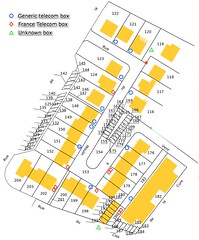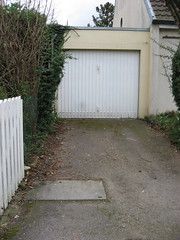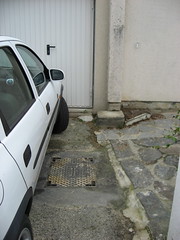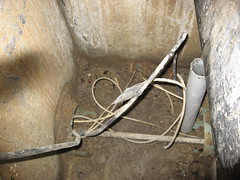Monday, March 3, 2008
Sunday, March 2, 2008
Rules regarding conduit in our residence - (Article 14: Passage de Canalisations)
The document is called the "Cahier des Charges du Lotissement et Association Syndicale" in French and my copy is dated 14 October 1970. Article 14 deals with the conduit in the residence.
Article 14: Passage de CanalisationsLes propriétaires de chaque lot seront tenus, sans indemnité, ni pouvoir s’y opposer, laisser passer dans leur sol ou sur leur lot, tous conduits nécessaires ou utiles a l’un quelconque des autres propriétaires pour l’alimentation ou le service de ses bâtiments, ainsi que pour les raccordements aux antennes collectives de radio-television (deux au total).
Dans chaque lot pourront passes des réseaux souterrains utilises au profit de l’un ou l’autre des lots.
Les occupants ne devront au droit de ces réseaux ni construire ni planter de végétations a racines longues susceptibles de les détériorer.
Le ou les propriétaires bénéficiaires de ces canalisations, réseaux et autres conduits seront tenus de remettre en état, a leurs frais, les lots qui auraient eu a subir des dégradations (tranchées par exemple) du fait de la mise en place, de l’entretien ou de la réparation des canalisations, réseaux ou autres conduit ce dessus vises.
The section starts by saying that the lot owners must allow the installation of conduit in their lots for the delivery of services. This includes a common antenna for radio/television. I understand the second paragraph to say that networks are allowed to run through the lots of any owner for the benefit of any of the lot owners. It goes on to say that the owners can't put bushes over the manholes or plant vegetation with long roots that could deteriorate the conduit.
I'm no lawyer but I understand the whole article to say that we should be allowed to run the fiber through all the conduit regardless of whether the lot owners approve or not. I'm not sure why they would actually object to another line in an existing conduit they'll never see. It is also interesting because the common antenna for radio/television isn't in use anymore (although pieces of it remain in the conduit) but some operators are installing a second fiber in their rollouts and using it to broadcast RF radio and television. It could be a way to justify the rollout legally if it ever came down to that.
Saturday, March 1, 2008
Conduit map of our residence - La carte des fourreaux dans notre résidence
 I was able to pull a great map of the residence off of the French site: http://www.cadastre.gouv.fr this morning. It's a government site where you can put in your address and they give you a map of your area with the official information about the lots in the area. After printing a copy, I went out early this morning looking for manholes to mark.
I was able to pull a great map of the residence off of the French site: http://www.cadastre.gouv.fr this morning. It's a government site where you can put in your address and they give you a map of your area with the official information about the lots in the area. After printing a copy, I went out early this morning looking for manholes to mark.I noted them all down on paper and then updated the digital map with all the box locations using Skitch. The blue circles on the map are original boxes and the red diamonds are the same boxes but with a France Telecom cover. Finally there were a few other boxes and I didn't know what exactly they were so I marked them with triangles. I may have missed a few boxes because I didn't want to go snooping in people's yards but I'll try to fill them in tomorrow.
Most of the boxes are really old and are made of concrete. I assume they were put in when the homes were initially built. Today an older resident told me the homes were first sold in 1971 so Zed's comment about the ducts belonging to the residence are probably correct. However, some of the boxes have fallen apart over time and they've been replaced with new France Telecom boxes. One of my friends in the neighborhood had France Telecom replace their box in the driveway this past year. I'll try and talk to him tomorrow to see how that worked and why France Telecom put in their own branded box.
I ran into a couple of residents while I was looking for the boxes and they all seem pretty excited about the prospect of better connections via fiber. I'm going to send off my application for the company (SARL) to my friend who is a lawyer tomorrow to have him look over before submitting the application next week. That will then allow me to contact the operators directly.



